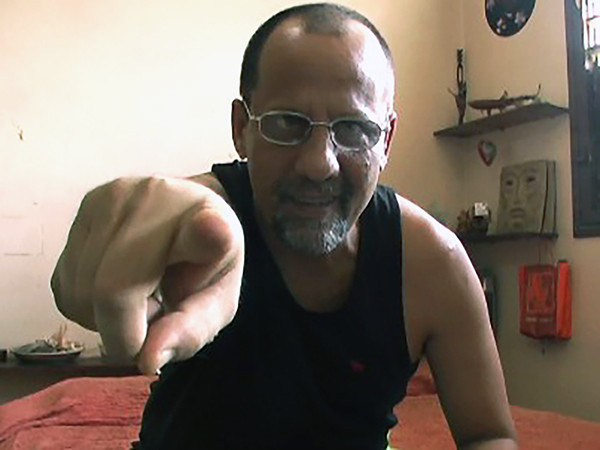Delivery

Juan Carlos Flores has earned recognition for his poems as written texts, and as a translator, I worked primarily within the visually oriented spaces of the page and the screen to recreate his work in English. [Click here to see the University of Alabama Press page for the book.] But Flores takes those same poems as scripts for performance, lending a whole other register to his work. To bring the texts into English without some commentary or other form of addressing performance — like the 2010 video I’m posting at the end of this entry — would greatly limit understanding of the work.
The term “performance” is vague, since it can refer to so many means and techniques for delivery. Musical and interdisciplinary elements will undoubtedly factor into future articles about Flores, as signaled in this entry at Cuba Counterpoints by Lizabel Mónica, who provides audio for a set of Flores poems as well as a short video.
As Mónica’s commentary suggests, the rap and hip-hop scene has drawn considerable attention to Flores’s community of Alamar, a housing community on the eastern outskirts of Havana, in the twenty-first century. The edition that I translated to English, The Counterpunch (And Other Horizontal Poems), forthcoming from the University of Alabama Press, is the second in a trilogy he dedicates to “the poetical resurrection” of Alamar.[2]
The dedication of the poems to Alamar is significant, and in the introduction to the book I spend time discussing some history of that community. But here I would like to draw out ways in which the ties between poems, performances, and place get complex.
The quality of not quite blending into any crowd strikes me as part of Flores’s power. That non-melding helps to demonstrate something about why Flores is now being seen as one of the most important and idiosyncratic figures in contemporary Cuban writing — on the page but, emphatically, also in his manipulations of performance.
I acknowledge, then, that pausing to note idiosyncrasy may create dissonance with the equally important assertion of a certain “representativeness,” insofar as that term can be used to talk about Flores, his poetry, and the specific locale of Alamar, with its own particular cultural activity. My insistence on marking that tension is grounded in a memory from the translation process.
Flores once asked me to make sure that over the course of the book, there would be a little awkwardness — and he did so in a particularly J.C. Floresian way: with great assurance, probably borne of a prolonged meditation on how to make sure his poems would live as they should; and offering an example to clarify his intention. What was it? The delivery of this poetry, he stated, must not sound as consistently smooth as the musical delivery of young Alamar hip-hop artists. It must not be as cool as they are.
After getting this request, I started to give more importance to poems that assert their characters’ age, inflexibility, and/or inability to adapt to changes in the society around them. One example is “The Smith” / “El enrejador.” Generating slight misalignment with a surrounding social context, rather than projecting smoothness and flow, is significant to the presentation of the book.
This entry concludes with a video I filmed of Flores reading four poems (in Spanish only) in early 2010, at the end of a visit to Alamar when we talked about the translation of the book.
The reading was informal and unprepared, certainly not to be represented as a fully realized Flores performance. Regardless, Flores’s composure and consistency on camera, along with the ability to string out a joke between poems (about reading “under protest”), give some sense of his level of experience with performing poetry.
At times, one hand describes circling and spiraling motions. As I discuss more in the book, Flores has spoken of his signature use of repetition as circles and spirals.
Note: This video is invisible in some browsers but visible in others.
Thanks to Brian D. Collier for his assistance with editing this video.
[1] The third collection in his trilogy has not appeared in print at the time of this writing. It is tentatively entitled Trapiche. Excerpted poems in English translation appeared in Mandorla and MAKE: A Literary Magazine.
Intermedium